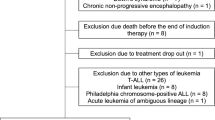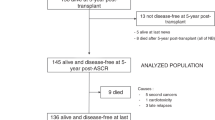Abstract
Impaired growth after TBI prior to BMT has been a constant finding in children with leukemia. The growth of poor-risk neuroblastoma (NBL) survivors treated with myeloablative preparative regimens and ABMT at the Hospital for Children and Adolescents, University of Helsinki, since 1982 is reported. Two separate groups were analyzed: (1) The TBI− patients (n = 15) were conditioned with high-dose chemotherapy only. They had been treated at the age of 1.0–6.3 (mean 3.0) years and the post-ABMT follow-up time was 1.5–14.5 (mean 7.7) years. (2) The TBI+ patients (n = 16) had received TBI in addition to high-dose chemotherapy. They had been treated at the age of 1.3–4.8 (mean 3.0) years, and the post-ABMT follow-up time was 1.5–8.0 (mean 4.7) years. The height standard deviation score (SDS) was similar for the two groups at the time of diagnosis, −0.3 ± 1.2 (mean ± s.d.), and at the time of ABMT, −0.7 ± 1.1. After transplantation, the height SDS continued to decrease in the TBI+ group, the mean being −2.0 SDS at 5 years after ABMT. In the TBI−group, the mean height SDS remained within −0.7 to −0.9 to the 10 years of follow-up. Five patients received growth hormone (GH) therapy starting 2–6 years after ABMT. They all had low GH secretion in provocative tests. All showed some response to GH therapy. The mean height SDS increased 0.4 SDS during the 3 years following the start of GH therapy, while in the untreated patients a decrease of 0.8 SDS during the corresponding time (P = 0.009) was observed. We conclude that NBL patients grow poorly following ABMT when TBI is included in the conditioning regimen, but close to normally when treated without TBI. The need for GH therapy should be evaluated early to avoid an unnecessary decrease in final height.
This is a preview of subscription content, access via your institution
Access options
Subscribe to this journal
Receive 12 print issues and online access
$259.00 per year
only $21.58 per issue
Buy this article
- Purchase on Springer Link
- Instant access to full article PDF
Prices may be subject to local taxes which are calculated during checkout
Similar content being viewed by others
Author information
Authors and Affiliations
Rights and permissions
About this article
Cite this article
Hovi, L., Saarinen-Pihkala, U., Vettenranta, K. et al. Growth in children with poor-risk neuroblastoma after regimens with or without total body irradiation in preparation for autologous bone marrow transplantation. Bone Marrow Transplant 24, 1131–1136 (1999). https://doi.org/10.1038/sj.bmt.1702021
Received:
Accepted:
Published:
Issue Date:
DOI: https://doi.org/10.1038/sj.bmt.1702021
Keywords
This article is cited by
-
Late endocrine effects of childhood cancer
Nature Reviews Endocrinology (2016)
-
Late effects in children treated with intensive multimodal therapy for high-risk neuroblastoma: High incidence of endocrine and growth problems
Bone Marrow Transplantation (2014)
-
Final height in pediatric patients after hyperfractionated total body irradiation and stem cell transplantation
Bone Marrow Transplantation (2007)
-
Long-term outcomes in children with high-risk neuroblastoma treated with autologous stem cell transplantation
Bone Marrow Transplantation (2007)



